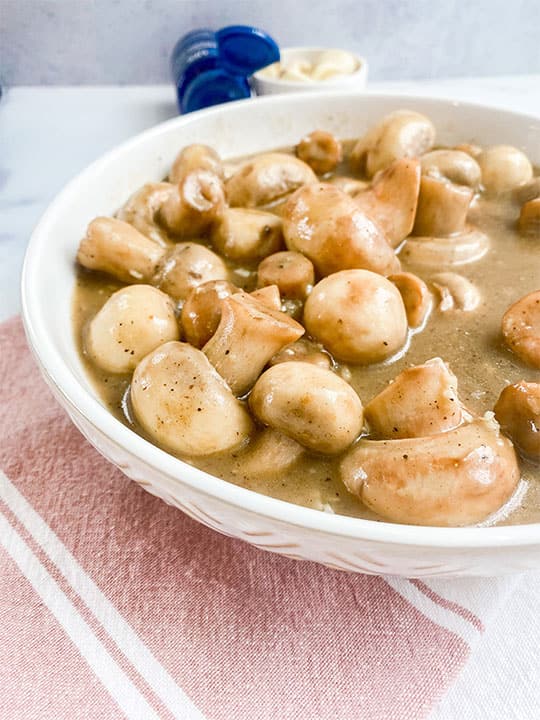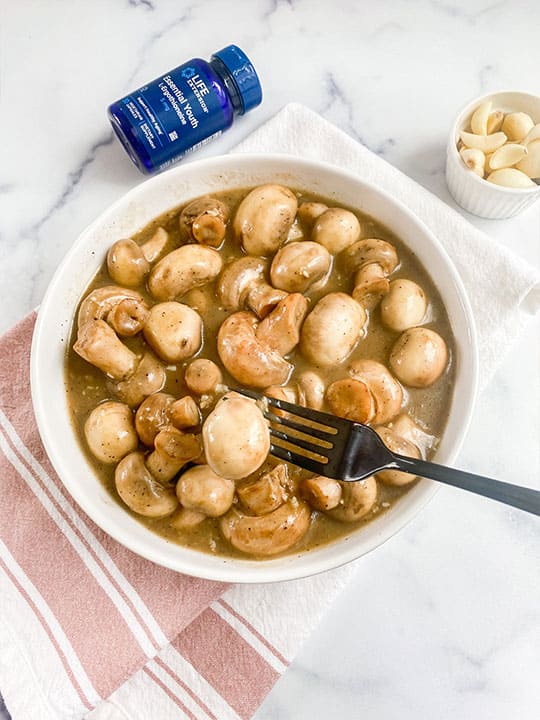
Sautéed Mushrooms Recipe: Anti-Aging Side Dish
Published: March 2022
We all dream of aging gracefully, with radiant skin, a sharp mind, a healthy body and a cheerful smile. Did you know the humble mushroom can help support those dreams?
Not only are mushrooms super-savory (especially with a little butter or olive oil and garlic), but they also contain some powerful anti-aging supplements to support longevity at the cellular level.
So, get ready for a great recipe that's perfect for a side dish or enjoyable on its own: garlic mushrooms! You'll love the crispy yet creamy texture, and since the starring ingredient has been linked to longevity, why not enjoy these sautéed mushrooms with dinner tonight?
Are mushrooms good for you?
Mushrooms come in many shapes and sizes, and they are quite healthy! Here are the most common types that can be found in the grocery stores (not to be confused with wild mushrooms):
- Shiitake
- Portobello
- Cremini
- Button or white mushroom
- Oyster
- Enoki
- Beech
- Maitake
These mushrooms have so many great qualities! They are fat-free, low-sodium, low-calorie, and cholesterol-free. They are also packed with minerals, vitamins, and fiber.
4 health benefits of mushrooms

While you're considering mushroom recipes, here's a few of the anti-aging benefits that mushrooms deliver:
Mushrooms are a rich source of vitamin D
—Only a few plant-based foods contain vitamin D, and mushrooms are one of them. Known as the sunshine vitamin, vitamin D is a star player in promoting bone health, and cognitive performance, supporting already-healthy blood pressure, immune health—and so much more.They support already-healthy blood pressure
—Mushrooms contain a decent amount of potassium, which supports already-healthy blood pressure. Some mushrooms also contain compounds that encourage immune health.They contain B vitamins
—Mushrooms are rich in B vitamins: riboflavin, niacin, and pantothenic acid. This combination helps support heart health.Mushrooms are a good source of beta glucans
—This soluble dietary fiber has been linked to heart health.
What do beta glucans do?
Beta glucans (also known as polysaccharides) are dietary soluble fibers that are broken down by enzymes and help support the body's healthy immune response. As noted above, they support heart health, and they also encourage digestive health, and promote healthy insulin response.
Ready to claim these health benefits for yourself with a mushroom recipe you can sink your teeth into? Read on for the perfect side dish!
Mushroom Recipe: How to Make Easy Sautéed Mushrooms

Many mushroom recipes are super easy to make, and this recipe in particular is delicious! I used white button mushrooms, but cremini mushrooms are also a good choice. This recipe also combines mushrooms with the immune-supporting power of garlic, doubling its health benefits thanks to this superfood ingredient.
Ingredients:
- 1 pound button mushrooms
- 4 tablespoon butter
- 1 tbsp minced garlic
- ¼ tsp dried thyme
- ¾ cup beef stock
- 1 tbsp flour (sprinkled—add more if needed)
- Salt and black pepper to taste
Preparation:
- Cultivated mushrooms can be cleaned using a damp paper towel to wipe off any dirt. You don't want to wash them because they absorb water, which dilutes their flavor.
- In a large skillet over medium-high heat, melt your butter and add your minced garlic.
- Once the garlic has started to sauté, add your mushrooms to the skillet. Season with thyme, salt and pepper.
- If you want your sauteed mushrooms crispier, leave out the beef stock. For a softer mushroom mix, add in some beef stock. You can also add a tablespoon or two of flour to thicken the stock into a creamy gravy that complements the garlic mushroom's flavor.
- Remove from the skillet and serve by itself or with a side of steak, pasta, or other main dish you love!
Healthy substitution: Extra-virgin olive oil

Butter indeed is what gives this garlic mushroom recipe a decadent taste and mouthfeel, but if you're looking for a more heart-healthy fat, I have a great ingredient alternative for you: you can't go wrong with olive oil! Sautéed mushrooms pick up the light, slightly peppery flavor of a really good oil variety. One tablespoon goes a long way!
Other ways to eat mushrooms
Luckily for you, mushrooms are very versatile! You can toss them chopped in a salad, sauté them in olive oil, or roast them with fresh parsley. They work well as a creamy mushroom sauce, an easy side dish or even a main dish. A creamy mushroom soup is always a great lunchtime treat.
If you are vegetarian, or just want a meatless meal, you can turn a portobello mushroom into a burger that has much less saturated fat than the meat-based version! You can also make sautéed mushrooms with chicken breasts for a delicious one-pot meal. Mushroom sauce is great over pasta, as well.
Or try stir-fry mushrooms with reduced sodium soy sauce for an Asian-inspired dish. There are many mushroom recipes to try!
Explore Our Best Anti-Aging & Longevity Supplements
Sauteed mushrooms recipe: Tips for success

- Never wash mushrooms in water—always use a damp paper towel in a single layer to clean and pat dry.
- You do not need to cover the pan when you sauté mushrooms, but you can if you want to make them softer.
- Sautéed mushrooms shrink slightly. If you are cooking them down, count on a 20-25% reduction as their water is released. The high heat will help caramelize the cooked mushrooms as you sauté, which adds to their flavor.
- You can add other seasonings that you personally enjoy to sautéed mushrooms, such as parsley, shallots, or white wine. What truly makes this mushroom dish tasty is the garlic and butter combo!
- Sautéed mushrooms can be served in a variety of ways. Have them on their own, toss with creamy pasta or add them as a side dish to a protein.
- Choosing to sauté mushrooms in butter, garlic, and beef stock makes for a great flavor combo! But you can use any fat, such as chicken fat if you plan to add the mushrooms to a chicken dish, or olive oil to cook your mushrooms (always choose an extra-virgin variety).
Don’t like mushrooms? Now what?
If you are not a fan of sautéed mushrooms, but want to reap their health benefits, there is a suite of longevity supplements.
One reason for those health benefits is ergothioneine, an amino acid found in high concentrations in certain mushrooms that has piqued the scientific community's interest due to its cell-protective properties and its great promise in supporting healthy aging!
How can I get enough ergothioneine in my diet?

Levels of ergothioneine have been shown to decline as we age. Thankfully, mushroom recipes aren't the only way to support longevity at the cellular level. Life Extension's Essential Youth L-Ergothioneine delivers 5 mg of ergothioneine, which has the following benefits:
- L-ergothioneine offers powerful cellular protection against oxidative stress
- It helps support healthy cellular aging
- It supports cognitive, vision and heart health
Other amino acids that promote health
Amino acids are the basic building blocks of life and are responsible for forming protein within the body. Our bodies use 21 different amino acids to form the proteins required for cells to function.
Nine of these aren't naturally produced in the body—they must be obtained through diet and supplementation. Life Extension's Branched Chain Amino Acids encourage protein synthesis, support exercise performance and muscle recovery, promote muscle function, and support healthy brain and immune function.
Even supplements often associated with serious athletes, such as L-glutamine, can be beneficial for anyone who wants to not only maintain muscle health, but also immune and gut health.
In addition to supporting your fitness regimen, amino acids such as L-theanine, L-Lysine, Taurine, carnitine and others play a role in mood, immune health and more!
Putting your health first doesn't have to be hard! Let us help you take the guesswork out of it so you can start your journey to a healthy well-balanced life!
References
- Cheah, Irwin K et al. "Ergothioneine levels in an elderly population decrease with age and incidence of cognitive decline; a risk factor for neurodegeneration?" Biochem Biophys Res Commun., September 2016, https://pubmed.ncbi.nlm.nih.gov/27444382/
- Shubrook, Nicola. "Top 5 health benefits of mushrooms." BBC Good Food, July 2021, https://www.bbcgoodfood.com/howto/guide/health-benefits-mushrooms
- Wantanabe, Fumio et al. "Vitamin B12-Containing Plant Food Sources for Vegetarians." Nutrients, May 2014, https://www.ncbi.nlm.nih.gov/pmc/articles/PMC4042564/
- Zhang, Ying et al. "Role of Selenoproteins in Redox Regulation of Signaling and the Antioxidant System: A Review." Antioxidants, March 2020, https://www.mdpi.com/2076-3921/9/5/383/htm
- "Dietary Reference Intakes for Calcium, Phosphorus, Magnesium, Vitamin D, and Fluoride." Institute of Medicine (US) Standing Committee on the Scientific Evaluation of Dietary References Intake. National Academies Press, 1997, https://www.ncbi.nlm.nih.gov/books/NBK109831/
- "Ergothioneine: Uses, Side Effects, and More." WebMD, https://www.webmd.com/vitamins/ai/ingredientmono-1183/ergothioneine
Like what you read?
Please subscribe to get email updates on this blog.




